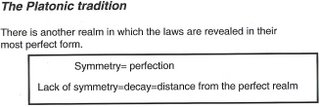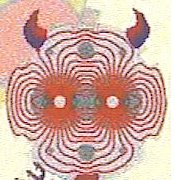I am not sure how this post is to unfold, yet in my mind different exercises were unfolding as to how I should explain it. Can I come from an
artist's perspective I wondered? Say "by chance" anything that seems relevant here in writing, and any relation to science "is" metaphorical by nature?
 Yellow, Red, Blue
Yellow, Red, Blue
1925; Oil on canvas, 127x200cm; Centre Georges Pompidou, ParisThese free, wild raptures are not the only form abstraction can take, and in his later, sadder years, Kandinsky became much more severely constrained, all trace of his original inspiration lost in magnificent patternings. Accent in Pink (1926; 101 x 81 cm (39 1/2 x 31 3/4 in)) exists solely as an object in its own right: the ``pink'' and the ``accent'' are purely visual. The only meaning to be found lies in what the experience of the pictures provides, and that demands prolonged contemplation. What some find hard about abstract art is the very demanding, time-consuming labour that is implicitly required. Yet if we do not look long and with an open heart, we shall see nothing but superior wallpaper.
I underlined for emphasis.
Does one want to gleam only what is coming across in geometrical form as a painting without understanding the depth of the artist in expression? Some may say, why any association at all, and just leave science to what it knows best without implicating any theoretical positions with the thought pertaining to gravity here.
Yes that's why I selected the title of this post as thus, and why I am going to give perspective to what I may, "as artist in writing" see with these words, and then you decide whether it is useful to you.
The Field as the PlaneAn ancient thought penetrated my thinking as I thought of "the field" that a society can work in agriculture, and yet, by definition it was the plane, "length and width" that was also appealing here. I did not want to loose it's "origination" while I moved any thinking to the "abstract of brane" and the like, without firmly attaching it to the ground.
But who was to know that this plane could be moved to any "fifth dimensional understanding" without having studied the relationship to dimensional thinking and the like. The physics elevated.
I allow this one time escapism to "other thinking" to demonstrate what use the colour of gravity implies while at the same time "theoretical positions" talk about it's place in the universe. If one did not accept the moves in science and the way it expressed itself to allow geometrical inclination, then how the heck could non-euclidean thinking ever make it's way into how we will discuss "the fields" about us?
It meant that a perspective "on height" be adopted? As an observer I was watching from a position. While in that sleeping/dosing state, I wondered how else to express myself as these concepts were amalgamating themselves into a "conceptual frame of reference?"
The picture of the field
(I am referring to the ancient interpretation) continued in my mind, and "by abstract" I thought to introduce a line extend from the centre of this field upward. So here I am looking at this field before me. Now I had wondered off previous by bring "the brane" in here, yet is not without that sight I thought how the heck could any idealization so ancient make sense to what the colour of gravity to mean.
 Title page of Opticks .... by Sir Isaac Newton, 1642-1727. Fourth edition corrected by the author's own hand, and left before his death with the bookseller. Published in 1730. Library call number QC353 .N48 1730.
Title page of Opticks .... by Sir Isaac Newton, 1642-1727. Fourth edition corrected by the author's own hand, and left before his death with the bookseller. Published in 1730. Library call number QC353 .N48 1730.So "an idea" came to mind.
While correlating Newton's work here and the "extra dimensional thinking," I also wanted to include the work of the
"Alchemist Newton". "To expand" the current thinking of our "emotive states" as a "vital expression of the biological being."
Draw into any further discussion of the "philosophical or other wise," these views of mine which are a necessary part of what was only held to a "religious and uneducated evolutionary aspect of the human being."
A cosmologist may still say that such thoughts of Einstein used in this vain is wrong, but I could never tear myself away from the views of "durations of time."
Colour Space and Colour Theory The CIE 1931 colour space chromaticity diagram with wavelengths in nanometers. Note that the colors depicted depend on the color space of the device on which you are viewing the image.
The CIE 1931 colour space chromaticity diagram with wavelengths in nanometers. Note that the colors depicted depend on the color space of the device on which you are viewing the image.So by having defined the "frame of reference," and by introducing "Colour of gravity" I thought it important and consistent with the science to reveal how dynamical any point within that reference can become expressive. The history in association also important.
In the arts and of painting, graphic design, and photography, color theory is a body of practical guidance to color mixing and the visual impact of specific color combinations. Although color theory principles first appear in the writings of Alberti (c.1435) and the notebooks of Leonardo da Vinci (c.1490), a tradition of "colory theory" begins in the 18th century, initially within a partisan controversy around Isaac Newton's theory of color (Opticks, 1704) and the nature of so-called primary colors. From there it developed as an independent artistic tradition with only sporadic or superficial reference to colorimetry and vision science.
So you tend to draw on your reserves for such comparatives while thinking about this. I knew to apply "chemical relations" to this idea, and the consequential evidenced, by the resulting shadings by adding. I wanted to show "this point" moving within this colour space and all the time it's shading was describing the "nature of the gravity."
Adding a certain mapping function between the color model and a certain reference color space results in a definite "footprint" within the reference color space
By adding that vertical line in the field, the perimeter of my field of vision had to some how be drawn to an apex, while all kinds of thoughts about symmetry and perfection arose in my pyramidal mind.
All these colours, infinite in their ability to express the human emotive state, as a consequence of philosophical and expressed as function of the emotive being?
CIE 1976 L*, a*, b* Color Space (CIELAB)CIE L*a*b* (CIELAB) is the most complete color model used conventionally to describe all the colors visible to the human eye. It was developed for this specific purpose by the International Commission on Illumination (Commission Internationale d'Eclairage, hence its CIE initialism). The * after L, a and b are part of the full name, since they represent L*, a* and b*, derived from L, a and b. CIELAB is an Adams Chromatic Value Space.
The three parameters in the model represent the lightness of the color (L*, L*=0 yields black and L*=100 indicates white), its position between magenta and green (a*, negative values indicate green while positive values indicate magenta) and its position between yellow and blue (b*, negative values indicate blue and positive values indicate yellow).
The Lab color model has been created to serve as a device independent model to be used as a reference. Therefore it is crucial to realize that the visual representations of the full gamut of colors in this model are never accurate. They are there just to help in understanding the concept, but they are inherently inaccurate.
Since the Lab model is a three dimensional model, it can only be represented properly in a three dimensional space.
Entanglement the quantum entanglement would become so spread out through these interactions with the environment that it would become virtually impossible to detect. For all intents and purposes, the original entanglement between photons would have been erased.
Never the less it is truly amazing that these connections do exist, and that carefully arranged laboratory conditions they can be observed over significant distances. They show us, fundamentally, that space is not what we once thought it was. What about time? Page 123, The Fabric of the Cosmo, by Brian Greene
So many factors to include here, yet it is with the "idea of science" that I am compelled to see how things can get all mixed up, while I say emotive state, or Colours of gravity?
It gets a little complicated for me here, yet the "Fuzzy logic" introduced or "John Venn's logic" is not without some association here. Or, the psychology I had adopted as I learnt to read of models and methods in psychology that could reveal the thinking we have developed, and what it included.
Least I forget the "
real entanglement" issues here, I have painted one more aspect with the "Colour of Gravity" to be included in this dimensional perspective, as we look to the models in science as well?
Working from basic principles and the history of spooky has made this subject tenable in today's world. A scientist may not like all the comparisons I have made based on it, I could never see how the emotive and mental statements of the expressive human being could not have been included in the making of the reality.
That I may of thought the "perfection of the human being" as some quality of the God in us all, would have granted sanction to some developing view of "religious virtuosity," against the goals of the scientist. So as ancient the views painted, there was something that may have been missed of the "Sensorium," and goes toward the basis of the philosophy shared currently by Lee Smolin.
This entanglement to me is a vital addition to our exploration of the universe. Our place and observation within it? It did not mean to discount our inclusion within it, within a larger "oscillatory perspective."
 The Man Who Tasted Shapes: A Bizarre Medical Mystery offers Revolutionary Insights into Emotions, Reasoning, and Consciousness, 2003: Revised MIT Press edition with new afterword
The Man Who Tasted Shapes: A Bizarre Medical Mystery offers Revolutionary Insights into Emotions, Reasoning, and Consciousness, 2003: Revised MIT Press edition with new afterword





















